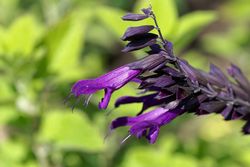Green Fingers in Autumn
Down at Caves Folly Nursery in Colwall, Bridget is reflecting on planetary movement and its importance to gardeners.
The Autumn Equinox has just taken place and it’s a beautiful time of year.
As we orbit the sun it illuminates the northern or southern hemisphere more depending on where the earth is along its annual path through space. At two points in the year the sun illuminates the northern and southern hemispheres equally. These are known as the equinoxes and it means that as autumn begins in the northern hemisphere, spring gets underway in the southern hemisphere at exactly the same moment.
With the shorter days here in the north, the plants start to slow down and prepare for winter. The wonderful colours of the trees are stimulated by the lower light levels of shorter days. There is less sunlight for photosynthesis and so the chlorophyll in the leaves dies off along with its green pigment.
As the overpowering presence of chlorophyll disappears, other chemical elements in the leaves take over to produce an amazing array of reds, yellows, purples and oranges. Eventually all the pigments disappear and the plants becomes dormant for the winter.
At the risk of sounding too much like Professor Brian Cox I will get back down to earth! Back in the garden there is always lots for us to do at this time of year.
This is a good time to trim hedges. Do not cut berries off the hedges, the birds need them. Hawthorn hedges should be cut when the berries have all gone.
October is a good month for splitting perennials and planting new ones, spring bulbs can be planted now and you can plant up winter containers with bulbs and winter bedding.
If you don’t have space to overwinter half hardy plants such as osteospermums or salvias then take semi-ripe cuttings and grow them on a sunny windowsill.
Now is a good moment to treat pots with nematodes to kill vine weevils. Hardy annuals such as calendula, honesty, can be sown directly into the soil.
In the kitchen garden harvesting is a priority, so get produce in before the damp and mould take hold. Sow winter greens such as mustard leaf, pak choi, mizuna and lamb’s lettuce in a greenhouse or under cloches for late autumn and winter harvests.
Use biological controls to reduce the damage of coddling moth on apples and pears. Tidy up and clean around strawberries, old leaves can harbour pests and disease.
You can do your bit for wildlife and the environment as well. Buy plants from nurseries that will let you return pots or buy bare root, which all helps save the amount of plastic pots needed. Install water butts to collect rain water and leave areas of the garden with long grass, old woody stems and leaves that offer shelter to invertebrates and other creatures. Soon it will be time to start feeding the birds to help them survive the winter.
Nature will carry on regardless, so I hope you can find time to enjoy nature’s wonderful finale to the season.
Bridget
Bridget runs Caves Folly Nurseries on Evendine Lane in Colwall (WR13 6DX). They are open from March until October, Thursdays to Saturdays from 10 - 5.
You can contact them on 01684 540631 or visit their website:
www.cavesfolly.com


